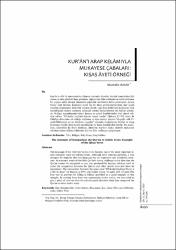| dc.contributor.author | Irmak, Mustafa | |
| dc.date.accessioned | 2020-12-19T20:42:11Z | |
| dc.date.available | 2020-12-19T20:42:11Z | |
| dc.date.issued | 2015 | |
| dc.identifier.citation | Irmak, M. (2015). Kur'ân'ı arap kelâmıyla mukayese çabaları: Kısas Âyeti örneği. Dinbilimleri Akademik Araştırma Dergisi, 15(3), 179-206. https://app.trdizin.gov.tr/makale/TVRrNU1UWXpNdz09 | en_US |
| dc.identifier.issn | 1303-9199 | |
| dc.identifier.uri | https://app.trdizin.gov.tr/makale/TVRrNU1UWXpNdz09 | |
| dc.identifier.uri | https://hdl.handle.net/11436/5668 | |
| dc.description.abstract | Kur'ân'ın dili ilk zamanlardan itibaren üzerinde durulan önemli konulardan biri olmuş ve aksi yöndeki bazı görüşlere rağmen bu dilin etkileyici ve taklit edilemez bir yapıya sahip olduğu düşüncesi çoğunluk tarafından kabul görmüştür. Ayrıca bizzat ilahî hitabın, kendisine denk hiç bir kitap getirilemeyeceğine dair güçlü meydan okumasının doğal bir sonucu olarak, onu Arap kelâmıyla mukayese edip üstünlüğünü ortaya koymaya çalışmak önemli faaliyetlerden biri hâline gelmiştir. Belâgat kaynaklarında îcâz-ı kısarın en güzel örneklerinden biri olarak takdim edilen "Fi'l-kısâsi hayâtün/Kısasta hayat vardır" (Bakara 2/179) âyeti ile Câhiliye dönemine ait olduğu söylenen ve aynı temayı işleyen "el-qatlü enfâ li'lqatli/Öldürmeyi en iyi öldürme engeller" sözünün mukayesesi, Kur'ân ve Arap kelâmının bütün detaylarıyla incelendiği en bariz örneklerden biridir. Bu makalede, zikredilen iki ibare özelinde, âlimlerin Kur'ân'ı başka sözlerle mukayese ederken nelere dikkat ettiklerine dair bir fikir verilmeye çalışılmıştır. | en_US |
| dc.description.abstract | The language of the Holy Qur'an has been become one of the most important issues discussed since the earliest times. Although some contrary opinions, it was accepted by majority that this language has an impressive and inimitable structure. As a natural result of the Holy Qur'an's strong challenge to the idea that the Qur'an cannot be compared to any text produced by human, scholars tried to make the comparison between the Qur'an and other Arabic texts and show its supremacy. The comparison between the qisas verse "Fi'l-kısâsi hayâtün/There is a life in qisas" (al-Baqara 2/179) and Arabic kalam "el-qatlü enfâ li'l-qatli/The best way to prevent the killing is killing" provided us a good example of this thought. By moving from these two expressions, in this article, we have tried to give a point of view on what the scholars paid attention when they compared the Qur'an to other Arabic texts. | en_US |
| dc.language.iso | tur | en_US |
| dc.rights | info:eu-repo/semantics/openAccess | en_US |
| dc.subject | Din bilimi | en_US |
| dc.title | Kur'ân'ı arap kelâmıyla mukayese çabaları: Kısas Âyeti örneği | en_US |
| dc.title.alternative | The attempts of comparison the Qur'an to arabic texts: example of the Qisas Verse | en_US |
| dc.type | article | en_US |
| dc.contributor.department | RTEÜ, İlahiyat Fakültesi, Temel İslam Bilimleri Bölümü | en_US |
| dc.contributor.institutionauthor | Irmak, Mustafa | |
| dc.identifier.volume | 15 | en_US |
| dc.identifier.issue | 3 | en_US |
| dc.identifier.startpage | 179 | en_US |
| dc.identifier.endpage | 206 | en_US |
| dc.ri.edit | oa | en_US |
| dc.relation.journal | Dinbilimleri Akademik Araştırma Dergisi | en_US |
| dc.relation.publicationcategory | Makale - Ulusal Hakemli Dergi - Kurum Öğretim Eleman | en_US |


















